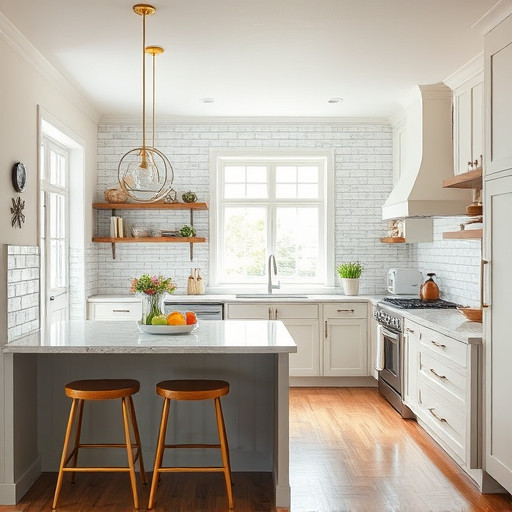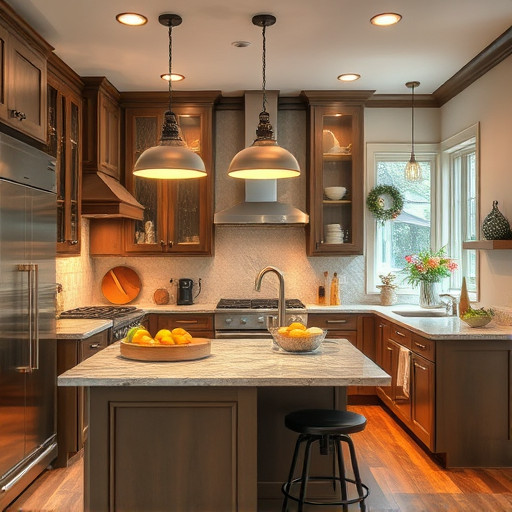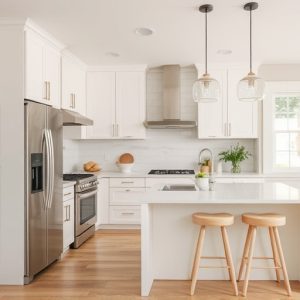Kitchen renovations often focus on lighting design as a key aspect to enhance both functionality and aesthetics. A layered approach with task, ambient, and accent lights is recommended to optimize the kitchen for cooking, dining, and socializing. Task lighting like under-cabinet or pendant fixtures ensures clarity for precise tasks, while ambient lighting from ceiling fixtures or recessed bulbs covers the entire space. Accent lighting can highlight architectural features or artwork, adding depth and design elements to the kitchen. For energy efficiency and long-lasting performance, LED light bulbs are a top choice, offering customizable color temperatures that complement various kitchen elements. Smart lighting systems allow for adjustable brightness and colors through digital interfaces or voice commands, enabling homeowners to fine-tune the kitchen's ambiance for different times and activities. Dimmers and smart controls add flexibility, making the kitchen adaptable from morning coffee to evening meals and beyond. Effective lighting design is a pivotal element of kitchen renovations, significantly impacting both the space's practicality and its visual appeal.
Illuminate your kitchen’s potential with expert guidance on lighting design and fixtures, transforming functional spaces into warm, inviting havens. This article offers a comprehensive guide to choosing the ideal lighting solutions for your kitchen renovation, ensuring every meal is not just flavorful but visually appealing under the right glow. Discover how to select fixtures that enhance both aesthetics and functionality in your culinary sanctuary.
- Kitchen Ambiance: Mastering Lighting Design and Fixtures for Enhanced Spaces
- Choosing the Right Lighting Fixtures for Your Kitchen Renovation
Kitchen Ambiance: Mastering Lighting Design and Fixtures for Enhanced Spaces

When it comes to kitchen renovations, lighting design and fixtures play a pivotal role in creating an ambiance that is both functional and inviting. A well-lit kitchen not only facilitates culinary tasks but also sets the mood for dining and socializing. To achieve this balance, consider layering your lighting with a combination of task, accent, and ambient light. Task lighting, typically provided by under-cabinet or pendant lights, ensures that countertops are well illuminated, making food preparation and cooking safer and more efficient. Ambient lighting, often from ceiling fixtures or recessed lighting, provides overall illumination to the entire kitchen space. Accent lights can highlight architectural details or a prized art piece, adding depth and interest to your kitchen’s design.
Selecting the right type of bulbs is also crucial in kitchen renovations. LED options are energy-efficient and have a longer lifespan compared to traditional incandescent bulbs. They also allow for a wide range of color temperatures, enabling you to choose the warmth or coolness of light that best complements your cabinetry, countertops, and overall color palette. Smart lighting systems can further enhance functionality by offering adjustable brightness and color options through smartphone apps or voice commands, allowing homeowners to fine-tune their kitchen’s ambiance to match the time of day or the occasion. Incorporating dimmers and smart controls also adds a level of flexibility, ensuring that your kitchen is versatile enough for early morning coffee preparation, evening family dinners, and late-night snack runs. With careful planning and consideration of both form and function, kitchen lighting design can significantly elevate the ambiance of the space during kitchen renovations.
Choosing the Right Lighting Fixtures for Your Kitchen Renovation

When embarking on a kitchen renovation, selecting the appropriate lighting fixtures plays a pivotal role in enhancing both functionality and ambiance. The right lighting can transform a kitchen from a mere cooking space into the heart of the home, where family and friends gather. Ambient lighting sets the overall tone, with options like recessed ceiling lights or track lighting offering a clean, modern look that complements the sleek surfaces typically found in contemporary kitchen designs. Task lighting is equally crucial; under-cabinet lights or pendant lights over the island provide targeted illumination for cooking, food preparation, and cleaning, ensuring safety and precision.
For kitchen renovations, considering the task at hand—such as the size of the space, existing architecture, and personal preference—will guide the choice of lighting fixtures. For instance, a galley kitchen might benefit from slimline pendant lights that don’t encroach on limited space, while an open-plan area with an island could accommodate more dramatic fixtures that serve as focal points. Additionally, incorporating dimmers allows for adjusting the light intensity to suit various activities and moods, from bright light for food preparation to a warm glow for casual dining or entertaining. Opting for energy-efficient LED options not only reduces electricity consumption but also provides a longer lifespan and better color rendering index, making it easier to appreciate the textures and colors of your kitchen renovation’s finishes.
In conclusion, crafting the ideal ambiance in your kitchen through strategic lighting design and fixture selection is a pivotal aspect of a successful kitchen renovation. The right illumination not only enhances the aesthetic appeal but also serves practical functions, transforming everyday tasks into more pleasurable experiences. By considering a blend of task, ambient, and accent lighting, homeowners can achieve a harmonious balance that caters to both form and function. Selecting from an array of fixtures, from sleek pendants over the island to warm recessed lighting, each kitchen space can be tailored to reflect its unique character and the homeowner’s personal style. A well-lit kitchen is not just a functional space but a statement of design and comfort that invites both efficiency and warmth into the home.
